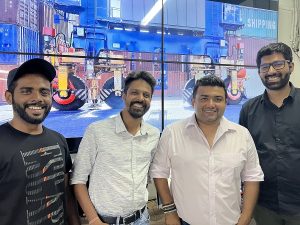Of the Channel, For the Channel, By the Channel

India’s leading tech OEMs looked at exploring different mechanisms to support their channel ecosystem during the pandemic.
The pandemic and its aftermath (the hard lockdowns and subsequent unlock phases) have had severe impact on the Indian IT sector. From large OEMs to enterprise customers, the impact has been severe across each and every single entity in the tech ecosystem. The channel ecosystem has been no exception. In fact the channel fraternity has been one of the worst affected and in the new normal is looking at devising newer ways to reinvent themselves.
A detailed investigation into the impact on the channel fraternity and how the top OEMs supported the ecosystem reveals a few important facets. Dissecting individually what each OEM did to alleviate the impact on their partners requires a more thorough perusal of these facets. Basically what these facets would include among others
• Relief packages and incentives provided by the OEMs to their partners
• Helping partners manage cash flow challenges especially in the light of payment default/deferment by customers
• Helping partners balance between retaining existing customers and acquiring newer customers
• Remotely supporting partners so that they in turn can provide timely remote services and support to the customers
• Sensitization of partners to virtual marketing campaigns and virtual closure of sales deals
• Support provided to the SMB customers directly or indirectly as this segment remains the economic backbone or mainstay of the partners
Keeping these outlined points in mind, ITPV dives deep into what the leading 5 tech OEMs were doing differently for their partners during these challenging times and how they helped the channel not just to stay afloat but ultimately flourish even in a pandemic scenario. From Dell, IBM, HPE, Lenovo and Oracle, ITPV explores to understand precisely their activities in the current scenario.
Partner Ecosystem Stages Revival
Anil Sethi, VP & GM –Channels, Dell Technologies explains how its partner ecosystem has rallied round in challenging times. “When we were completely under the lockdown state, and the crisis started hitting and people started realizing the impact, there were three things which we commonly heard from the partners. One was definitely cash, which was the biggest issue and it continues to remain so. That was where they needed help.
The second was that they were working with their customers to see how they can help them and to help customers they required some deliveries to be happening because customer needed certain things. These things were just coming up because work from home culture was suddenly implemented across.
The third was to see that, how we can help their existing sales force when they are interacting with the customers, how they can be more effective and how we can build skills towards them when they talk to the customers so that they are able to make meaningful conversations,” explained Sethi.
Dell had working capital solutions implemented where it gave extended partners extra credit lines, depending upon to the partner or extra credit period. This helped partners to resume new business, close new business and at the same time when the collections were not happening it was quite helpful to them. The cost of capital in India is high, so when this extension and credit lines help them, adding up to the profitability as well, by the way.
Dell, claims Sethi, has one of the best supply chains in the world and even during this time it never had any major, serious delivery issues like deliveries not being there. Obviously it was not getting it into the country, and everyone was actually hit. But still Dell did a lot of things for the partners. It got some of the planes chartered and managed important deliveries for customers and partners to ensure that work from home was implemented immediately. In terms of deliveries the effective supply chain helped them meeting customer demand and needs at that point in time.
Third thing, for the people Dell had set up special trainings for the teams and this was in fact given free of cost to the partner representatives and partner sales force. And there was high skilled certifications done, trainings done on storage, compute, hybrid cloud and multiple kinds of technologies. These are the kind of things which went on and that helped partners come back and today we are in extremely good road to recovery.
Dell also looked at effectively balancing between new client acquisitions and retaining existing customers by partners in these pandemic times. “Strategy does not change over acquisition and retention of the customers. That continues but during this time the partners reach out to their existing customers,” Sethi clarifies. Most of the partners help them in reorganizing their workloads, helping them in ensuring their business continuity and ensuring that how there is a seamless work that happens for them. So that was something which everybody did with their existing customers. It was a great time to demonstrate the two partnerships.
There are always new customers. Acquisition is of two types. One when the partner does it himself and the other when Dell passes it on to the partner. So from July, we seem to restocking about 60% of the partner operations and they are back and their teams and people are operating and the customer interactions have dramatically increased. “When I compared it from May and June, acquisition is working well and I think in coming months, it would be much better,” informs Sethi.
Marketing priorities definitely went digital. All digital aspects of marketing are being implemented by our partners. In fact, Dell had gone ahead and said that people can take cash of 50% of their MDF to do any of the marketing activities and we also help them in case they are required to hire resources. An extremely special thing during this time for partners was to ensure that they continue to work towards creating demands in the market, and so Dell needed to support their marketing initiatives.
Dell has also been working with its distributors to see that there is good visibility across the market about all its cloud solutions, and all its work from home solutions. How are they different? How does a customer need to understand that? So all of those activities continue, and there are different ways that partners have adopted. Virtual meetings have been one big success stories across the industry. “I think that has definitely been very helpful for people to stay connected. There was a big customer event which was done by our one of the partners virtually,” informs Sethi.
On the outreach thing, Dell has put up a different plan. It is working with the partners to see how they can use some of our marketing development funds, see that how both can mutually add more capacity into those areas and see how both can reach out and ensure that we help start the business back into some of those tier 3 and tier 4 towns. These things are planned and largely being worked with the distributors.
Dell also helped partners during this time to manage their cashflow issues, which were rising. “We said that you can have a 50% of the MDF funding cashed and then can you put it into the marketing activities to generate demands or hire resources. We also offered free trainings on storage. These are generally paid trainings, which were given to the partners and technical teams free of cost,” informs Sethi.
Not just partners, even Dell team prefers physical face to face meetings to close deals. When things get tough, adoption actually happens very fast. This was a very different time. So this is a time everybody across the globe has accepted this new norm. It is about certain expectations. Some of the discussions happened much faster and the closures happened much more fast than it would have happened on face to face meetings because there was fixed timings.
“You come on and actually interact and share data, share your analysis or whatever you want to talk about. Just that we are not sitting physically, the point is not that as if we are alone, but it is also that customer is not there. So, this situation is global or cross India and hence this new format meeting became acceptable. We all have accepted that this is going to live for long and for some time. Maybe it is not to that level as it was earlier, but I am sure it is going to improve and reach to that level soon,” he concludes.
Partners Shift Focus Towards Cloud Services
Lata Singh, Executive Director – IBM Partner Ecosystem & CSI elucidates on the partner ecosystem dynamics and how IBM has helped them during the pandemic. “The ecosystem actually reinvented itself, and that applies to both customers and partners. Just like there are customers in different phases, there are also partners in the ecosystem who are in different phases. As a lot of the infrastructure was on-prem, they realized that they needed to build offerings for their clients, which are on cloud based model and accordingly reinvented themselves. The aim was to see what can I deliver to the client which is more service-related and less only infrastructure related so that the services revenue increases for them,” she explains.
This was one transformation in terms of the business that the partners did themselves, because they realized that they needed to look at what the client needs now and therefore change their business models. That is something which is happening now and will continuously happen. Now, what did IBM do here? First of all, it did a re-imagine partner program. IBM realized that the ecosystem is changing. There are traditional partners and a traditional model of engagement, which is a pure play sale of systems, sale of cloud and cognitive software. That sale remains and the important thing is how partners get incentivized on that part of it.
The other is what IBM calls embed and that is where partners look at building solutions. So how are partners building applications or building solutions for the clients where the component is embedded in this solution? That is key because the clients are looking at solutions and are not looking at bits and pieces that are being resold to them. “We looked at embed and we looked at a partner program that looks at payments or incentives, according to the build part of it,” informs Singh.
Finally in services, it is important to see how a partner is building capabilities or services around IBM portfolio managed services, managed stock services, or DevOp as a service. Building service business out of IBM portfolio and these are the three that IBM really built into a program for its partners to say, “look as you are transforming the current environment and some of you have already transformed, we are reimagining our partner program to give you those benefits from that”.
Secondly, IBM spent a lot on engagement on helping its partners with digital marketing. Now that is something that has been core to IBM, but it was a good way to get partners on board to understand how digital marketing works. How do we get their clients to come on board and do that.
Thirdly, IBM also looked to enable them to build skills that are in its portfolio as well and the people say that it as good as the people who understand the technology and how to sell it. “Therefore we have a seismic platform which is where IBM has also get their certifications learning and our partners are also on-boarded onto that. That is the capability building, learning that we did,” explains Singh.
IBM actually broke it down into different programs– first the incentivization scheme, which is into the build, service, sales. Then it got into the entire marketing platform and helping them to get into the digital marketing world, which is so critical right now. Finally skills because it is a critical factor as to how do they build their sales capability, technical capability and deployment capabilities. These are the areas that IBM focused on.
From the cash flow perspective, IBM looked at it from two fronts. One is who is paying the partners– it is the end client. IBM Global Finance looked at the customers and looked at how could it be used for financing the clients. When the clients take IGF, the payment structure to our partners is easy. That is the first part where IBM is talking to the clients and looking at the ability to embed IGF into its engagements with the clients which obviously translates to ease of doing business for the partners.
The second was obviously depending on quarter on quarter. “How we run out more on very short term focused engagement, how we had schemes that ran through Q3 and obviously Q2 on what do you get if you have deals that are in the pipeline, and how do we convert them? Do you get an additional margin? All of that also came into it. I would call it multilayer engagement that we do it through the pandemic to support our partners and obviously to support the IBM business,” Singh elucidates.
IBM announced a $1 billion cloud engagement fund and that is available to the entire channel ecosystem because it wanted organization or partners to build capability on the IBM portfolio. It wanted to give them technical skills that will help them move their applications to the cloud or solutions to the cloud.
This was also available for the Indian ecosystem to take and cuts across GSIs, RSIs, our VADs, the startup ecosystem and solution provider, the ISV ecosystem. Now, that is a lot of money. “It is up to the ecosystem to come forward and say, look, we are interested, help us build a business case and we will look at obviously putting that to worldwide, getting the engagement fund to them, and then working to actually embed their solutions with an IBM portfolio and then also technically help them to move that to the cloud. We are putting our money on the table for our partners to say, how do they adopt and how do they transform because of what we are doing right now and we are keen to engage with the ecosystem,” explains Singh.
IBM was earlier doing a number of physical events where it looked at how many people turned up. That just got translated into the digital pieces. “To us this is maturing and along with our partners we do not want to do one to many like the physical events. We want to do one to a few focused set of your clients where we are very clear about what is the solution that we want to propose and how do we really have a one to one experience with your client so that we are able to articulate what is the technology that is best for their business and also understand what are they seeing the changes and what would they want us to do.”
“It became from one to many, to one to few because ultimately it is the quality, and not the quantity and then we progressed. Now that we have got the CIO or the CXOs on WebEx with our partners and again, depending on the partner’s capability, in terms of solutions and industry, we segmented them,” Singh adds.
A recent survey that was done with Fortune 500 companies, the CIOs actually said that they’ are interested in investing more in digital transformation, close to 75%. That did not mean that the others did not, it meant the others were already investing. But they want it to obviously accelerate that. That is a very positive sign from what happened in early in 2009, where CIO is, did not want to invest. They wanted to invest only on keeping lights up. That is the difference between 2009 to what we have now in pandemic situation.
Therefore the number of engagements that IBM did with client includes also seeding in the thought of what is possible. Therefore, when you are seeding in front of what is possible or what can be done through various technologies to meet the business needs. “It is not just that we are talking about what happened in the last three months, but also what are the plans for the future? That is a discussion that has been very strong with our clients, through our partners. What are they looking at? What are the different models they are looking at? Where do they want to invest? How has that investment changed? And as long as you are getting those insights, I would say that is building up very strong pipeline for the future and that is what counts.”
SMBs in IBM ecosystem really have a large place. Around April sometime IBM announced a number of our cloud solutions are available 90 day free for trial and that encouraged a lot of SMB customers, as well as partners to obviously download and look at what applications or what solutions that they could do as well as what they could use in their running environment. And that is one part of obviously addressing a larger ecosystem which includes the clients as well as the partners.
The second piece is the fact that a number of IBM partners built offerings, which are remote offerings or on the cloud offerings, around the IBM portfolio that they rolled out to the SMB segment. That was an important piece because organizations, which were used to be on-prem and seeing people also in terms of services being offered by engineers on-prem, actually moved to SLA-based requirements, moved to managed services, moved to public cloud, moved to a hybrid cloud model.
That was the critical piece because more than looking at, what did we do it was the whole way that they were looking at buying, which was more CapEx buying getting converted to OpEx buying and that was a big shift. The entire shift to the cloud was one of the key things and therefore, a lot of the SMBs used IBM cloud. “They did use multi-cloud sensors, multiple other clouds as well, but the fact that our partners are able to deliver them key critical IT services in an OpEX based model is, is what I would say the IBM solution offerings provided to SME via partner ecosystem,” concludes Singh.
Reiterates Channel and SMB Commitments During Pandemic
Ashish Sikka, Director SMB, Lenovo India explains the dynamics of the partner ecosystem and how it has benefited Lenovo even during the pandemic. “We have been working with our channel partners very closely. Channel partners are the backbone of our business in India for overall Lenovo, especially for SMB business. There is uncertainty all around, particularly economic uncertainty. It is about where do you invest money and where you do not invest money in business and we see the same with our customers as well as channel partners. That is where our Lenovo Financial Service offering comes in handy where we offer channel financing to our channel partners, work with them to offer short term leads and long-term leads to their customers,” he explains.
Lenovo has seen channel partners use some of their channel solutions very well during the pandemic. “ all know how manpower went restricted and people are struggling, and that is where a lot of channel partners have used deployment and configuration services. This was to make sure that when the device reaches their customers it is a plug and play device and the customers also do not lose their productivity and at the same time the channel partners do not put their employees at the risk of pandemic,” explains Sikka.
Sikka claims Lenovo’s incentive program or rebate structure is actually one of the best in the industry. It provides very consistent rebate programs to its channel partners. The channel partners look forward to two things– one is profitability, but more than profitability they look forward to predictability. The partners want to make sure that if they are investing in business the cash flow is predictable, they know what kind of profit they will be making out of that. They do not want something which gives them one quarter or one year of very exponential profit and another year it goes down.
At the end of the day it does take a toll on the channel partners and their employees. Sikka claims Lenovo’s program has been very consistent and very linear. Lenovo has ensured the partner profitability remains in picture, and they are able to serve the customers in a better way. Lenovo worked on them to identify the right use which should be calling in the market, it worked with them to try and figure out that what kind of support services it should be giving in the market.
One of the things which Lenovo has been propagating with partners and which partners utilised a lot is the Lenovo Financial Services. It is the Lenovo financing arm through which partners use channel financing, take advantage of short term leaves, long term leaves, short term rentals and long term rentals to their customers. Some of the cases where the channel was stuck up Lenovo offered extra credit days and extra credit facilities to them to come over the pandemic situation. “We have seen channel respond quite well on the same and that is what lead to our success. We saw ourselves sitting number #1 with a share of 33.7% at a growth of 14.7% year on year basis and that would not have been possible without the support of all the channel partners,” adds Sikka to corroborate what he claims.
Indian SMBs wanted to adopt Technology and it just got accelerated a bit. Some of the businesses which was maybe not looking at technology has started looking at technology in a new light or how it can help them to do business better and how it can help them to realise better avenues, how it can allow their employees to be more productive.
The other big realisation for SMBs and it is also a mindset change is that the work can happen remotely. Otherwise mostly in SMBs the employees had to come to office and then only the work will happen.Aas much as it has been a technology mindset change, it has also been a culture mindset change for SMBs.
During this time what was important when Lenovo spoke to channel partners was availability of relevant information. Lenovo Pro Connect app is an app which basically connects Lenovo directly to all the channel partners. Lenovo focused and concentrated a lot on its app, made improvements in that, built up and did changes so that the partners can see all the resources whether it is product, service, escalation matrix in one place. Lenovo walked in a focused manner so that it did not bombard its partners with unwanted information but help them to tide through these tough times because obviously they were facing the same challenges as Lenovo was.
“One of the things which is there in the back of the mind is that is this a true DaaS model or not. We go and educate, we run them through all the things which are there and we make sure that they understand that what is being offered by Lenovo is actually a true dash model available for them and this is the major challenge which we have seen in adoption of DaaS from them,” says Sikka.
Simplifies Partner Engagements
Sanjoy Mukherjee, Senior Director & Head of Alliances & Channels ,Technology and Cloud Platform Oracle India elucidates on Oracle’s cloud strategy and the roles of the partner ecosystem. “We treat partners as an extension of the organization itself and hence it becomes very important that we enable partner resources like every other resources in our own organization, because they will go and propose the solution, the services, the builder on top of a flat platform,” claims Mukherjee.
Oracle has modernized its partner program, which it calls as Oracle Partner (OPN 2020). It is a very simplified program. “An enhanced OPN program has been designed to accelerate our partners own transition to cloud, as well as drive a superior customer experience and business outcome. From this perspective now with the present scenario, if you look at it, our primary focus is to make it possible for our customers to continue running their operations and help them quickly respond to the unique demands they may be facing during this challenging time,” he explains.
Even though OPN 2020 was launched before the pandemic, in overall perspective during the pandemic, this has helped the partner by providing them with extended services. These include the requirements partners asked for, be it universal credit for developing their cloud offering on our cloud platform, or maybe pertaining to specific new offerings as they go to the market with the customer needs.
Now during the pandemic time working along with the partners, Oracle has seen a lot of specialization drive, which has been taken up by the partner themselves for their organization. From an Oracle perspective, it has with the partners to see that they get more specialized, there are free Oracle cloud infrastructure certifications during the COVID times. There are in-depth learning, which has been made very easy because this is the only way of getting those learning now. It is this in-depth which has helped partners.
There is a repository for the partners which it used for internal purpose or internal employees like sales central, workload, estimator, cost estimator, the cloud economics which the partner has started utilizing very effectively and which showing results. There was something called Oracle Digital Marketing Center for driving campaigns. Oracle continues to work closely with all its partners to ensure that there is business continuity.
Oracle also ensured that from a cashflow perspective, how it could help the partners improve the situation so that impact is lesser from the segment perspective and also from case to case perspective. It worked together along with the partner to ensure that things worked out possibly so that the impact from an overall perspective is less even in the forms of some extended thing from an case to case basis, depending on the segment which got affected from an overall perspective. “We try to work on case to case basis with the partners from that perspective and few areas but there we followed a common policy from that perspective,” emphasizes Mukherjee.
Oracle also looked at balancing between retaining existing customers and acquiring new customers. It worked with the existing clients to give new solutions to them or expand the solution. Even in these times, there have been new acquisition of customers and from a different segment perspective, including Government, manufacturing BFSI.
OPN 2020 has the customer centricity which helped the partners to showcase their expertise and enable customers to identify partners that will deliver value for the specific needs. Overall it was a success driven approach where increased investment in enablers, designed to build their own expertise, to drive customer success, grow partner revenue and accelerate path to cloud. It was a very simplified process where Oracle had streamlined and made it easier for the partners to engage with Oracle and leverage industry broadness and most integrated cloud and on-premise portfolio.
OPN has along with expanding the reach of partners has also been able to serve our existing customers. “We have been able to work with our existing customer to look at their new solution, or for example, an on- premise customer to move some of their workloads to cloud and also work on parallel on other workloads from a future perspective,” emphasizes Mukherjee.
The partner community has also helped us to work along with them to work on new deals, new customer acquisition in the form of cloud and on-premise, both. That extends more of the cloud IaaS and SaaS perspective. Along with our partners, Oracle has been able to acquire new customers as well as retain existing customers. In this scenario, there are certain people have moved their whole game plan and moved as transformation so that they have their business continuity in future.
The OPN simplified program is helping Oracle as it has people to work with different set of partners. Even from an Oracle perspective, sometimes a partner will play in all the four areas, a bigger SI may do that, but otherwise it is very clear, the partner focus perspective where they are playing. For example, someone is playing from a re-sale perspective only, someone is playing only from a cloud service perspective or someone is playing from a cloud resell perspective. Everywhere we have people even inside company, we have worked and built our teams so that our partners, whoever is focused on whichever approach we can support them.
“We precisely understand that each of these players are different. An ISV is different from an SI and services focus versus the reseller focus and what it means from a customer relationship perspective that is why we are able to cater to all of them in a better way while driving success for them and their end customer,” adds Mukherjee.
Additionally, what we do along with partners is for each of these partners for their specific focus area, we continue to constantly invest in skilling, re-skilling, up-skilling our partners and whichever partners want to rescale and upscale and move to cloud, we try to help them from our partner perspective also, our partners from a cloud first world perspective also.
Pitches Partners for an Edge to Cloud Experience
Joybrata Mukherjee, former Director – Channels, SMB, Services, HPE India explains HPE’s Strategic Direction especially in the post-pandemic era. In India, about 85% of HPE’s overall hardware revenue is indirect and goes through the partners. The partner categorization starts with our Tier 1 partners, who are the distribution partners. There are about 4-5 top distribution partners. HPE does business directly with the different distribution partners.
Then HPE has its Tier 2 partners like the resellers, system integrators who work closely with end customers, understand their requirements and do the system integration and deployment part with the end customers. Along with HPE, they do implementation, overall deployment, project management with customers.
Within Tier 2 partners, there are 3 categories. One is the Platinum partner, then we have the Gold partner, then Silver and below that what we call the Business partner. Between Platinum and Gold, who are the top partners, HPE will be having about 75 partners within India. And then HPE will have about 300-350 Business partner where a few of them is managed directly by HPE and the long tail part is managed by the distribution partners. As a part of the SIs, HPE has the large SIs and India SIs among others.
“When we actually analyze the situation, the biggest problem which all our partners were facing, whether Tier 1 or Tier 2 partners, was a complete cashflow choke. The end customers were deferring payments to the Tier 2 partners, and the Tier 2 partners were not paying to theTier 1 partner,” informs Mukherjee.
Overall Tier 1, i.e. the distribution business, is completely on a return on working capital. So the cash flow is the most important part of that business. If there is a cash flow choke, if the Tier 2 partners are not paying them margins they operate at, the cost of interest, as well as the margins the business operates becomes pretty insignificant and they came under a lot of pressure. The credit insurers also took a very cautious stand in terms of coming out with credit rating for most of the large enterprise customer, which was much worse than before the pandemic.
The business was not happening because of the cash flow issues. So as part of a worldwide initiative, HPE came out with a financial package which was a kind of moderation on the payment system. This was very well appreciated by its partner ecosystem. Generally Tier 1 partner does business with HPE at 45 days credit. Now it came out with a much better overall deferred payment solution along with our Tier 1 partner, which really helped that business for the Tier 1, as well as that between Tier 1 and Tier 2, because the moment it was giving a deferred payment solution to our Tier 1 partner, they can pass that over that to the Tier 2 as well. That helped a lot in terms of ensuring that business flow is there and also they can come out of that cashflow choke situation.
SMBs have been the fastest growing and a completely partner led motion. HPE only governs it but partners create opportunity. And that business growth is dependent pivoted around the partner. There is a problem in terms of a cashflow choke that HPE faced in the firstthree months of the pandemic. Now slowly it is improving.
In terms of giving financial support to our partners overall, HPE Financial Services came out with $2 billion package during lockdown. Primarily, HPE utilized that funding to help itsr partners in terms of providing them as well as our end customers with deferred payment solution. Secondly, using consumption based payment models also helped the SMBs. The third thing which became very popular is infusing cash or capital by buying back assets. If anybody wants to do a refresh on old infrastructure, what we do is that we assess those infrastructure, attach a commercial value, take back or buy them back and infuse cash in the system. The SMB customer or the enterprise customer can utilize that cash to actually invest in new projects or do whatever, because he wants that cash. Then for the new infrastructure, we provide them a deferred payment solution. “Plus three months payment holiday and a series of things, which we announced for our partner, as well as for end








